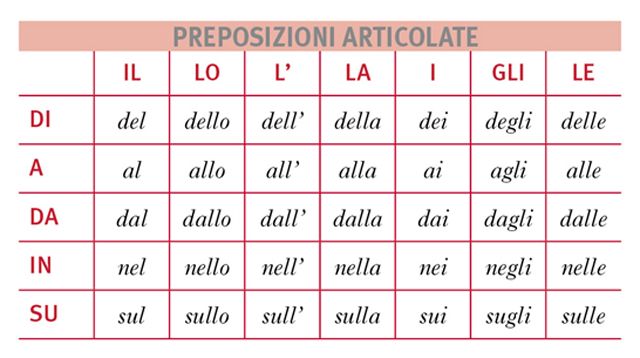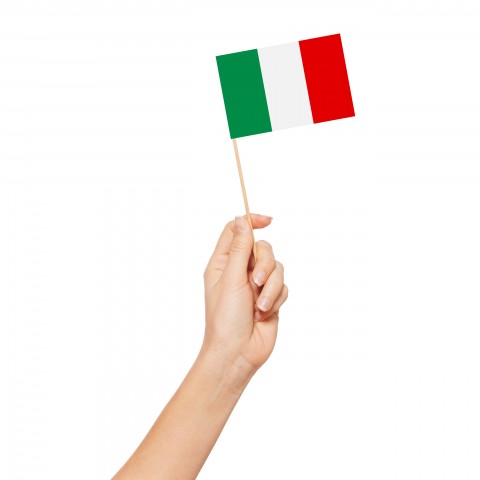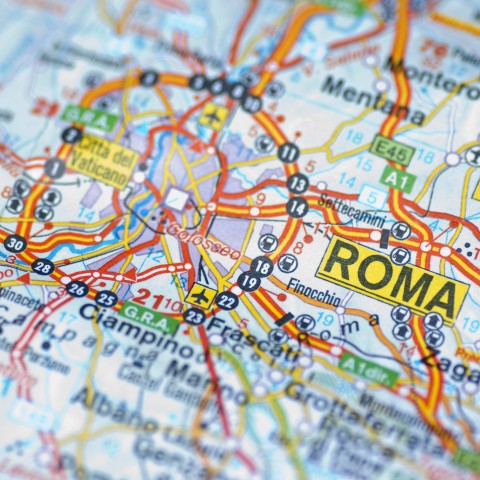Today we’re going to be talking about a very short yet extremely important word in Italian: e which means and.

Just as in English, e can join two nouns, verbs, adjectives, adverbs or sentences.
Ho guardato un film e poi sono andato a letto.
I watched a film and then I went to bed.

Similarly to how a almost always changes to an in English in front of a vowel (for example: an apple), e changes to ed in certain situations. This d is called a ‘euphonic d‘, generally occurring when the initial vowel of the following word is also e as in the examples below.
Mario ha chiuso la porta ed è uscito di casa.
Mario closed the door and left the house.
Lucia è colta ed elegante.
Lucia is educated and elegant.
In front of the vowels a / i / o / u, the euphonic d is normally omitted, though this ultimately comes down to the style and choice of the speaker. For example, either of the following sentences would be considered acceptable:
- Io e il mio amico = Correct
- Io ed il mio amico = Not incorrect but less common
According to Treccani, a specific situation where it is preferable to avoid using ed is when the following word also starts with the sound ed, such as for example, cortile ed edificio (courtyard and building). (But this doesn’t mean you won’t hear people using it!)
And if that wasn’t confusing enough, some speakers tend to drop the euphonic d even if the following word starts with an e. We can put this down to contemporary spoken Italian being far less strict than Florentine-based literary Italian.
Io e Enrico siamo amici da sempre.
Enrico and I have always been friends.

The moral of the story is that the more you speak and hear Italian, the more attuned your ear will become to when e sounds better than ed and vice versa.
Finally, as in English, you can start a phrase with e for emphasis. For example:
Paolo mi ha deluso. E io che pensavo fosse una persona affidabile!
Paolo disappointed me. And I thought he was a reliable person.

Ask anyone from Italy, and chances are, they’ll know the following line of verse: «di, a, da, in, con, su, per, tra, fra.»
Indeed, most cultures in the world have their own nursery rhymes and songs. While they might appear to be nothing more than a cute or silly little arrangement of words, there is actually quite a bit going on under the surface. Poetry tends to be set to a certain rhythm (called a meter), and every word is carefully chosen to accentuate this rhythm. These nursery rhymes stick with children while they grow up, helping them to internalize the musicality of their language or even remember some information.
If you don’t believe me, have a listen to this song (lyrics). It is the verse we learned up above put to music, and I guarantee that after just a single listen, you’ll likely find it impossible to forget a single one of the prepositions.
But before we can talk about Italian prepositions, we need to talk about articles.
The 7 Italian Articles
English has three articles: the, a and an. «The» is the definite article, while «a» and «an» are indefinite articles. Just in case that terminology is new to you:
- Definite articles refer to a specific thing. When a supervillain commands his henchman to press the button, he has a specific button in mind.
- Indefinite articles are used when there isn’t a specific right answer and anything will do. As such, magicians ask you to pick a card—any card.
Italian is a bit more complicated than that. The below are all definite articles, meaning that each one of them translates to the in English. Having said that, each one is used in a different situation. Using one when you should have used another will make your sentence difficult to understand.
| Preposition | Usage |
|---|---|
| Il | Used with masculine singular nouns that begin with a consonant. |
| Lo | Used with masculine singular nouns that begin with S + Consonant, GN, PN, PS, X, Y or Z. |
| I | Used with masculine plural nouns that begin with a consonant. |
| Gli | Used with masculine plural nouns that begin with S + Consonant, GN, PN, PS, X, Y, or Z. |
| La | Used with feminine singular nouns that begin with a consonant. |
| Le | Used with feminine plural nouns that begin with a consonant-vowel pair. |
| L’ | Used with singular nouns that begin with a vowel, whether masculine or feminine. |
Now that we are familiar with our articles and are able to recognize them in a sentence, we can move on to prepositions.
What is a preposition?
The Merriam-Webster dictionary defines preposition as follows:
A preposition is a word—and almost always a very small, very common word—that shows direction (to in «a letter to you»), location (at in «at the door»), or time (by in «by noon»), or that introduces an object (of in «a basket of apples»). Prepositions are typically followed by an object, which can be a noun (noon), a noun phrase (the door), or a pronoun (you).
If it helps, the prefix pre means before. While very flexible and capable of going almost anywhere in a sentence, prepositions typically come before the words they are modifying.
In Italian, we will need to learn about two types of prepositions: Simple prepositions and articulated prepositions.
Simple Prepositions
The simple prepositions, or preposizioni semplici, are named such because they are single-syllable words that stand on their own. As they don’t need to be conjugated, they’re also quite easy to use.
The only tricky thing is that, due to the flexible nature of prepositions in both English and Italian, they don’t have a simple translation. Whereas bambino will always mean boy, you have to look at the context of what is being said to know how to translate a preposition.
When to use di, a, da, in, con, su, per, tra, fra
Below is a list of the simple prepositions and a few example sentences.
Di — of/from/at/about, and can also be used to indicate possession
| Italian | English |
|---|---|
| Io sono di Verona. | I’m from Verona. |
| Lui parla sempre di ragazze. | He always talks about girls. |
| La casa di Anna è piena di gente. | Anna’s house (the house of Anna) is full of people. |
Da — similar to di, but often used (or even combined) with the preposition a
| Italian | English |
|---|---|
| Da uno a dieci, questa nuova esperienza è un dieci! | From one to ten, this new experience is definitely a ten! |
| Da Maria ho mangiato il pesce. | I ate fish at Maria’s. |
| Sono a casa. | I’m at home. |
In — used to indicate location, just like the English word in
| Italian | English |
|---|---|
| Sei in Italia? | Are you in Italy? |
Con — with
| Italian | English |
|---|---|
| Oggi esco con Sara. | I’m hanging out with Sara today. |
Per — for
| Italian | English |
|---|---|
| Un regalo per te! | A gift for you! |
Tra / Fra — between / among. They mean the exact same thing, but depending on what is being said, it may be more common to use one over the other. Tra is more common.
| Italian | English |
|---|---|
| Tra voi due, secondo me lui è più bravo. | Between the two of you, he is better than you. |
| Tra tutte queste persone, lei ha scelto me. | Among all these people, she chose me. |
Su — on/about/over, used to indicate the location of something or someone
| Italian | English |
|---|---|
| La penna è su quella scrivania. | The pen is on that desk. |
Articulated Prepositions
The articulated prepositions, or preposizioni articolate , are prepositions that combine with definite articles to form a single compound word.
The table might look complicated, but once you learn the articles and prepositions, combining them becomes very intuitive.
Note: Tra and fra are not in the table because they cannot be combined with articles. Con and per can be combined with prepositions, but very rarely.
Examples of the most common articulated prepositions
Again, as all of these prepositions are combining with definite articles, the English translations will all be (preposition) + the: to/at/in/around/from/etc the…
Note that, in some of the examples, an article is necessary in Italian but not in English. For example, whereas we say in space in English, Italians say nello spazio – in the space.
Del, dello, dell’, della, dei, degli, delle are formed by taking the i from di, replacing it with an e, then adding an article. This happens because, with few exceptions, one vowel can not directly follow another vowel in Italian.
Additionally, if the article starts with an L, double the L. For example, di and le combine to form delle—the l of le was doubled, the i of di became an e. This L-doubling rule applies to all articulated prepositions.
| Italian | English |
|---|---|
| Oggi sono andato dal meccanico perché la mia macchina è rotta. | Today I went to the mechanic because my car is broken. |
Al, allo, all’, alla, ai, agli, alle
| Italian | English |
|---|---|
| O vai al cinema, o vai a ballare! | You either go to the cinema or dancing! |
| Il bar apre all’una e mezza. | The bar opens at half past one. |
Note that the word una begins with a vowel. In cases like this, you should choose the articulated preposition that ends in an apostrophe, which is capable of combining with other words.
Dal, dallo, dall’, dalla, dai, dagli, dalle
| Italian | English |
|---|---|
| Vado dallo psicologo due volte a settimana. | I go to the psychologist twice a week. |
| Hai sbagliato strada; si va dall’altro lato. | You took the wrong route; it’s on the other side. |
Nel, nello, nell’, nella, nei, negli, nelle are prepositions that follow the double L rule, but also get rid of the preposition’s initial vowel. From there, because something like nl or nllo would be awkward to pronounce, an extra e is added.
| Italian | English |
|---|---|
| Non c’è aria nello spazio. | There is no oxygen in space. |
| Nell’antica Roma, l’olio d’oliva era molto comune. | In Ancient Rome, olive oil was very common. |
Sul, sullo, sull’, sulla, sui, sugli, sulle
| Italian | English |
|---|---|
| Ho messo i tuoi vestiti sulle scale. | I put your clothes on the stairs. |
| La chiave è sul tavolo. | The key is on the table. |
Note: These final seven articulated prepositions can not be used as adverbs. That basically means that it must be followed by a phrase introducing a location or direction. Here are two English examples demonstrating what I mean:
- On as a preposition: Put the shirt on your back.
- On as an adverb: Put the shirt on.
Conclusion
Wow, that was a lot of rules! But try not to worry about it too much. As you get to know the prepositions and articles better, combining them will come naturally. You’ll probably make mistakes at first, but that’s okay. Making mistakes when learning a new language is essential.
After all – what better way to learn if not by having that a thought process like “I made this mistake the other day, I was given the solution and now I know what not to do.”
Read more
- Some Italians Don’t Even Use Italian? A Spotlight on Italian Dialects
- How to Order the Best Italian Food in Italian
- Follow Glossika on YouTube / Instagram / Facebook
Subscribe to The Glossika Blog
Get the latest posts delivered right to your inbox
Learning how to use Italian prepositions correctly will make all the difference in the world when it comes to speaking like a native speaker.
Prepositions are often tricky to learn, but they are some of the most commonly used Italian words.
What is tricky are not the words themselves, of course, but how to use them and where to place them within the sentence, and they are incredibly important to make sure you get the right meaning across.
In this post, you will find all you need to know about Italian prepositions and how to use them in all kinds of contexts.
Whenever you’re in doubt, just come back here and have a quick read… You’ll learn how to use the correct preposition in no time!

What are prepositions?
Let’s start from the basics: a preposition is a short word, usually made up of just two or three letters in the Italian language, that explains how the rest of the words in a sentence are connected or related; it basically provides us with context to know how different concepts are linked.
Prepositions can complement an adjective, adverb, verb, noun, or pronoun.
What is tricky about Italian prepositions is that they are usually similar to English prepositions, which is surely helpful to know, but they cannot always be used in the exact same way.
Italian prepositions list

But enough with the introductions; let’s get to it.
The key prepositions are the simple prepositions (preposizioni semplici) are di, a, da, in, con, su, per, tra/fra.
And here are the general English translations for them, just so you have an idea.
- DI – of / from / about
- A – at / to
- DA – from / since / by
- IN – in
- CON – with
- SU – on / about / above
- PER – for
- TRA/FRA – in / between / among
Let us now look at each preposition in more detail, with examples of their usage in different Italian sentences.
Italian prepositions: DI and DA
As we’ve seen, DI can be translated into the English “of,” “from”, and “about”. The preposition di is used:
- To talk about ownership
Questa borsa è di Eleonora.
This bag is Eleonora’s.
- To describe materials and substances
La mia maglia è di cotone.
My shirt is made of cotton.
- With city origins (after the verb essere)
Io sono di Roma, e tu di dove sei?
I am from Rome; where are you from?
- With some expressions of time: parts of the day and days of the week
Mi piace leggere di sera.
I like reading at night.
Di lunedì vado a lezione di yoga.
On Mondays, I go to a yoga class.
- To describe topics with verbs such as parlare (to speak/talk), discutere (to discuss), etc.
Stiamo parlando di politica.
We’re talking about politics.
- To make comparisons
Questo caffè è molto più buono di quello.
This coffee is much better than that one.
- For authorship
Ho comprato un libro di Baricco.
I bought a book by Baricco.
- To explain quantities
Vivo in un edificio di 20 piani.
I live in a 20-floor block.
DA can be translated as from/since/by, and it is used:
- With origins of movement and motions “away from“
L’ho buttato giù dalla finestra.
I threw it out the window.
Sono partita da casa mia.
I left my place.
- With movements toward a person
Oggi vado a pranzo da Michele.
Today I’m going for lunch at Michele’s.
- To talk about what needs to be done (followed by an infinitive)
Ho tantissimo lavoro da finire!
I have too much work to finish!
- To describe how long something has been going on
Studio italiano da 2 anni.
I’ve been studying Italian for 2 years.
- To describe the agent in passive sentences
Questa commedia è stata scritta da Gogol.
This comedy was written by Gogol.
Italian prepositions: IN and A
IN is usually translated as “in”; pretty simple! We use it:
- To describe the movement to or state in a place (with countries and regions. With cities, we use a)
Sono in Francia.
I am in France.
Domani andiamo in Puglia.
Tomorrow we are going to Puglia.
- For traveling by means of transportation
Siete venuti in treno o in aereo?
Did you come by train or by plane?
- When talking about seasons
I fiori sbocciano in primavera.
Flowers bloom in spring.
- To describe the amount of time it takes to do something
Ho finito il libro in soli tre giorni.
I finished the book in just three days.
A is the Italian equivalent of “at/to”. It is used:
- To talk about the movement to a city/location or being in a city/location
Domani vado a Milano per lavoro.
Tomorrow I am going to Milan for business.
Andiamo al mare questo weekend?
Shall we go to the seaside this weekend?
- To say when or at what time something is happening
Esco dalla palestra alle sei di sera.
I leave the gym at 6 pm.
- To say you’re giving something “to” someone
Ricordami che devo dare 10 euro a Maria.
Remind me I need to give 10 Euros to Maria.
Italian prepositions: SU and CON
SU can be translated as “on/above/about” and we use it to indicate:
- That something is on top of or above something else
Il tuo quaderno è sul tavolo.
Your book is on the table.
- The subject of a topic
Ieri ho guardato un documentario sulla storia russa.
Yesterday I watched a documentary about Russian history.
CON is the equivalent of “with”. You can use it:
- To talk about company
Andiamo al cinema con mia cugina stasera.
Tonight we’re going to the cinema with my cousin.
- To describe the use of a tool
Ho fatto un succo di mora con il frullatore.
I made blackberry juice with the blender.
Italian prepositions: PER and TRA/FRA

How to Learn Languages Fast
PER is the Italian equivalent of “for”. It is used:
- To talk about reason or cause
Mi sono trasferita qui per lavoro.
I moved here for work.
- To express duration
Abbiamo parlato per più di 2 ore.
We talked for over 2 hours.
- To talk about a country of destination or a transport passing through one
Il mio volo passa per la Danimarca.
My flight goes through Denmark.
Domani Gianluca parte per la Colombia.
Gianluca is leaving for Colombia tomorrow.
TRA and FRA are interchangeable prepositions; they have exactly the same meaning, and using one, or the other is up to the speaker’s personal preference and stylistic decisions.
Use these to:
- To describe something that is located between two things
Mi è caduto il telefono tra il divano e la credenza.
My phone fell between the sofa and the dresser.
- To indicate “in how long” something will happen
Il concerto è tra una settimana.
The concert is in one week’s time.
- To differentiate between options
Tra i due preferisco questo.
I prefer this between the two.
Italian prepositions with articles
Now that you’ve learned how to use the Italian prepositions in a sentence, there is one more thing to know about them: DI, A, DA, IN and SU can become articulated prepositions (preposizioni articolate) when they are used before a definite article, as you probably have noticed in the examples above.
To form these we simply join the preposition with the definite article we need, so that they become one word (for example, di+il= del; a+le= alle etc.)
Have a look at the Italian preposition chart below, in which you’ll find all the major prepositions in combination with articles.
| il | lo | la | l’ | i | gli | le | |
| di | del | dello | della | dell’ | dei | degli | delle |
| a | al | allo | alla | all’ | ai | agli | alle |
| da | dal | dallo | dalla | dall’ | dai | dagli | dalle |
| in | nel | nello | nella | nell’ | nei | negli | nelle |
| su | sul | sullo | sulla | sull’ | sui | sugli | sulle |
Practice with Quizlet
Here’s a set of flashcards and quizzes to practice this grammar topic.
Italian prepositions recap
So, today we’ve seen that prepositions are short words that connect and give relative meaning to the concepts within a sentence. They can be tricky to learn, but once you do, you will be closer and closer to sounding like a native Italian speaker.
The main Italian prepositions are di, a, da, in, con, su, per, tra/fra.
Of these, di, a, da, in, and su can join onto articles to become preposizioni articolate. After all, it is not that complicated!
All you need is a bit of practice, and you will master Italian prepositions in no time!
Still translating in your head? Wanna speak Italian for real? Check out Stefano’s courses to think directly in Italian and become fluent fast!
Italian prepositions are like almost everything else in the Italian language: hard to understand at the beginning, but poetic and lovely to the ear. Well, with this comprehensive guide to prepositions in Italian by ItalianPod101, you’ll learn Italian prepositions in the blink of an eye.
We’ll cover the basics of Italian prepositions and when to use them, using charts and examples so that understanding Italian prepositions has never been clearer. It’s Italian prepositions made easy!
Table of Contents
- What is a Preposition?
- How to Use Italian Prepositions
- Main Italian Prepositions
- Main Prepositions + Article
- Learn Italian with Ease at ItalianPod101
1. What is a Preposition?
But first, we must start with the basics: the very definition of a preposition.
A preposition is a small word that connects two words or sentences that have a specific relationship to each other.
For example: The cat is in the box. The preposition here doesn’t connect them in a one+one relation—that’s a conjunction (e.g. Angela and Luke are going to meet some friends).
Instead, a preposition adds some information regarding the relationship between the two elements it connects. For example, it tells you that the cat is in the box, not on the box or beside it.
2. How to Use Italian Prepositions
In Italian, there are basically two different kinds of prepositions:
- Main prepositions (preposizioni proprie in Italian)
- Main prepositions + article
Then there are words that can be used as prepositions but also have other uses (preposizioni improprie in Italian), and prepositions made of more than one word. In this article, we’ll talk about the main prepositions (preposizioni proprie) and their combinations with articles.
Yes, we know, grammar is complicated. But we’ll show you how to use prepositions in Italian with the help of some examples, and everything will become much simpler.
3. Main Italian Prepositions
The main prepositions in Italian are: di, a, da, in, con, su, per, tra, fra. Let’s see each one of them in detail.
1- Di
As far as simple prepositions in Italian go, di is by far the most important and versatile preposition of all. It may have a lot of different functions within a sentence. The most important are:
- Specification
- Aspettiamo l’arrivo di Marta.
“We are waiting for Marta’s arrival.”
- Aspettiamo l’arrivo di Marta.
- Naming
- Stiamo entrando nella città di Roma.
“We are now entering the city of Rome.”
- Stiamo entrando nella città di Roma.
- Fault
- Il colpevole di questo crimine è stato trovato.
“The person who’s guilty of this crime has been found.”
- Il colpevole di questo crimine è stato trovato.
- Penalty
- Ho dovuto pagare una multa di 80 euro.
“I had to pay an eighty-euro fine.”
- Ho dovuto pagare una multa di 80 euro.
- Origin
- Sono di Bologna.
“I’m from Bologna.”
- Sono di Bologna.
- Subject
- Vorrei parlarti di Marco.
“I’d like to talk to you about Marco.”
- Vorrei parlarti di Marco.
- Agent
- I tuoi pantaloni sono macchiati di sugo all’arrabbiata.
“Your trousers are stained with arrabbiata sauce.”
- I tuoi pantaloni sono macchiati di sugo all’arrabbiata.
- Material
- Adoro le case di legno.
“I love wood houses.”
- Adoro le case di legno.
- Abundance
- Lucia è sempre così piena di energia.
“Lucia is always so full of energy.”
- Lucia è sempre così piena di energia.
- Limitation
- Il Marocco è un paese povero di acqua.
“Morocco is a country that’s poor in water.”
- Il Marocco è un paese povero di acqua.
- Cause
- Sto tremando di rabbia.
“I’m shaking with rage.”
- Sto tremando di rabbia.
- Partition
- Questa è la piazza più bella di tutte quelle che abbiamo visto.
“Of all the squares we’ve seen, this is the most beautiful.”
- Questa è la piazza più bella di tutte quelle che abbiamo visto.
- Comparison
- Firenze è più piccola di Milano.
“Florence is smaller than Milan.”
- Firenze è più piccola di Milano.
- Quality
- Cerchiamo persone di talento.
“We are looking for talented people.”
- Cerchiamo persone di talento.
- Weight or measure
- Ho comprato un melone di 3 chili.
“I’ve bought a three-kilo melon.”
- Ho comprato un melone di 3 chili.
- Specific time (when)
- La libreria è chiusa di lunedì mattina.
“The bookstore is closed on Monday mornings.”
- La libreria è chiusa di lunedì mattina.
- Continued time
- Ho fatto un viaggio di un mese negli Stati Uniti.
“I took a one-month trip to the United States.”
- Ho fatto un viaggio di un mese negli Stati Uniti.
It can also connect a sentence with a clause. For example:
- Teresa mi ha chiesto di tornare da lei.
“Teresa has asked me to come back to her.” - Ti ringrazio di essere così gentile con me.
“Thank you for being so kind to me.” - Ti ordino di smettere.
“I order you to stop.”
2- A
Another one of the simple Italian prepositions is a, which becomes ad when used before a word that starts with a vowel. It may be used in a sentence for many purposes:
- Indirect object
- Questa canzone è dedicata a mia moglie.
“This song is dedicated to my wife.”
- Questa canzone è dedicata a mia moglie.
- Being in a place
- Stasera voglio stare a casa.
“Tonight I want to stay at home.”
- Stasera voglio stare a casa.
- Specific time (when)
- Comincerò l’università a settembre.
“I’ll start university in September.”
- Comincerò l’università a settembre.
It can also connect a sentence with a clause when the clause is related to a cause or goal:
- Mi sbagliavo a fidarmi di lui.
“I was wrong to trust him.” - Sono venuto a congratularmi con te.
“I’ve come here to congratulate with you.”
3- Da
Da is another Italian preposition with a lot of different functions. In a sentence, the most important are:
- Going from a place
- Sono partito da Roma questa mattina.
“I left Rome this morning.”
- Sono partito da Roma questa mattina.
- Going to someone
- Per favore, torna da me.
“Please, come back to me.”
- Per favore, torna da me.
- Being at someone’s place
- Stasera vado a dormire da Michela.
“Tonight I’m going to sleep at Michela’s place.”
- Stasera vado a dormire da Michela.
- Agent and cause
- Marco è stato aiutato dai suoi amici.
“Marco has been helped by his friends.”
- Marco è stato aiutato dai suoi amici.
- Separation
- Luca è molto diverso da suo fratello.
“Luca is very different from his brother.”
- Luca è molto diverso da suo fratello.
- Specific time (from when)
- Il corso ricomincerà da lunedì.
“The course will start again on Monday.”
- Il corso ricomincerà da lunedì.
- Continued time (for how long)
- Danila è a casa da due ore.
“Danila has been home for two hours.”
- Danila è a casa da due ore.
- Price
- Il mio capo ha un’auto da 80.000 euro.
“My boss owns a 80.000-euro car.”
- Il mio capo ha un’auto da 80.000 euro.
- Manner
- Si è comportato da stupido.
“He acted stupid.”
- Si è comportato da stupido.
- Purpose
- I tuoi occhiali da sole sono davvero belli.
“Your sunglasses are really nice.”
- I tuoi occhiali da sole sono davvero belli.
It can also connect a sentence to a clause related to a goal or consequence. For example:
- Ho riso tanto da piangere.
“I laughed so much that I cried.” - Mi resta solo un episodio da vedere.
“I just have one episode left to see.”
4- In
This preposition is mostly used for the following functions:
- Being in a place:
- L’ufficio è in via San Felice.
“The office is on San Felice Street.”
- L’ufficio è in via San Felice.
- Period of time:
- Ho speso tutto il mio stipendio in 5 giorni.
“I spent all my salary in five days.”
- Ho speso tutto il mio stipendio in 5 giorni.
5- Con
Con is basically the same as the English preposition “with”:
- Aspetta, vengo con te.
“Wait, I’ll go with you.” - Con questo caldo, bisogna bere molta acqua.
“With this heat, you have to drink a lot of water.”
6- Su
Su is used mainly for:
- Being on something
- Il gatto è salito su un albero.
“The cat has climbed on a tree.”
- Il gatto è salito su un albero.
- Manner
- Prepariamo torte su richiesta.
“We bake cakes upon request.”
- Prepariamo torte su richiesta.
- Subject
- Ho scritto un libro sulla mia esperienza.
“I’ve written a book about my experience.”
- Ho scritto un libro sulla mia esperienza.
- Fraction
- Quasi una donna italiana su due non lavora.
“Almost one in two Italian women doesn’t work.”
- Quasi una donna italiana su due non lavora.
7- Per
In most sentences, per can be translated to the English preposition “for.” For example:
- Oggi devo comprare un regalo per mia figlia.
“Today I have to buy a present for my daughter.” - Per un bel concerto, sono capace di fare centinaia di chilometri.
“I can travel hundreds of kilometers for a good concert.” - Il vestito sarà pronto per venerdì.
“The dress will be ready on Friday.” - Giulia parte per New York domani mattina.
“Giulia is leaving for New York tomorrow morning.”
But it’s also used for clauses related to a cause or goal:
- Sono partito un’ora fa per arrivare puntuale.
“I left an hour ago to arrive on time.” - Per fare carriera il mio collega farebbe qualsiasi cosa.
“To move up in his career, my colleague would do anything.”
8- Tra and fra
Tra and fra are identical in meaning and function. Their main uses in a sentence are:
- Going through a place
- Siamo passati tra le due case.
“We passed between the two houses.”
- Siamo passati tra le due case.
- Distance (in space and time)
- Arriveremo tra due ore.
“We’ll arrive in two hours.”
- Arriveremo tra due ore.
- Company
- Amo passare le vacanze fra amici.
“I love to spend the holidays among friends.”
- Amo passare le vacanze fra amici.
- Continued time
- Tra il 2015 e il 2018 ho abitato a Milano.
“From 2015 to 2018 I lived in Milan.”
- Tra il 2015 e il 2018 ho abitato a Milano.
4. Main Prepositions + Article
Italian prepositions and articles combine to form single words. But it’s important to note that Italian articles and prepositions combine only when the article is definite. That’s to say, only when it’s il, la, lo, l’, le, i, or gli, and when the preposition is di, a, da, in, and su (con and per only in ancient Italian). Everything will be clearer with this Italian prepositions + articles chart:
| Il | La | L’ | Lo | I | Gli | Le | |
|---|---|---|---|---|---|---|---|
| Di | Del | Della | Dell’ | Dello | Dei | Degli | Delle |
| A | Al | Alla | All’ | Allo | Ai | Agli | Alle |
| Da | Dal | Dalla | Dall’ | Dallo | Dai | Dagli | Dalle |
| In | Nel | Nella | Nell’ | Nello | Nei | Negli | Nelle |
| Su | Sul | Sulla | Sull’ | Sullo | Sui | Sugli | Sulle |
Here are some examples of Italian prepositions and articles:
- Hai portato la macchina dal meccanico?
“Have you brought the car to the mechanic?” - Ho lasciato l’agenda sulla scrivania, al lavoro.
“I’ve left my diary on the desk, at work.” - Attento, è pericoloso tuffarsi dagli scogli!
“Careful, it is dangerous to dive from the rocks!”
5. Learn Italian with Ease at ItalianPod101
Grammar can be harsh and complicated, but it’s easy to learn when you can follow the lessons whenever you want and study in an entertaining, interactive environment. That’s ItalianPod101.
Here on our site, you’ll find comprehensive guides like this one that’ll help you become a master of the Italian language, with tons of examples and tips. Download our apps or enjoy our video lessons from your PC, and whenever you have a doubt or just want to chat, you can find fellow students on our forum. Don’t be shy!
Before you go, let us know in the comments how you feel about Italian prepositions. More confident, or do you still need some Italian prepositions help? We look forward to hearing from you, and will help out the best we can!
Prepositions are invariable (they do not change) items in the Italian language, and they are used to connect words or sentences.
They can be followed by a noun, a pronoun, an infinitive verb, and they can have, as in other languages, many different meanings and uses, according to the context.
Don’t worry….time, practice, and passion for Italy and its wonderful language will help you in the study of prepositions!
Simple prepositions in the Italian language
Let’s start with the most common uses of simple prepositions:
The preposition “di”
- Can indicate who is the owner of something
- Can express the material of which an object is made
- Can introduce the origin of someone or something (verb to be + di)
- Can indicate the age of someone or something
- Is used when before an adjective there is an indefinite pronoun
Examples:
The preposition “a”
- Is used with names of cities and small islands (or what the Italians consider to be small islands!)
- Is used to introduce a time, a month, an age
Examples:
The preposition “da”
- Can indicate an origin
- Is used with verbs indicating where a movement has started
- Can express who does something
- Indicates the function of an object
- Introduces a period of time begun in the past and not yet concluded
- Indicates a particular moment in time, or a condition in the past
- is used when, before an infinitive verb, there is an indefinite pronoun
- Is often used together with the preposition A in the expression “da…a…” to indicate a well-defined period of time
Examples:
The preposition “in”:
- Is used with the names of nations, continents, regions, streets, and big islands
- Is used with means of transport (however, we say “andare a piedi”
- Is used with names of places that end up in -ia
Examples:
 The preposition “con”:
The preposition “con”:
- Can indicate company, participation, correspondence, and is usually used with verbs that indicate relationships between objects or people
- Can introduce a way to do something or reach a certain objective
Examples:
The preposition “su”:
- Is used to introduce a topc
- Can indicate the position of something which is higher, or on top of something else
Examples:
The preposition “per”:
- Is used to indicate a destination
- Is used to indicate going through something
- Is used to indicate the time by which something happens or must be done
- Is used to indicate a precise period of time
- Can indicate the cause of something
- In the structure “per + infinitive”, it expresses the aim for which something is done
- Indicates the receiver of a benefit
Examples:
The preposition “tra” o “fra”:
- Can be used to talk about a time or a place, and in particular to indicate something which is clearly defined between two points
- Is used to express a period in the future
Examples:
Articulated prepositions in the Italian language
Sometimes prepositions are followed by a definite article. In this case, the prepositions di, a, da, in, su join the article to form a single word: an articulated preposition. Con, per, tra, fra can also be followed by an article, but in this case the two words remain separate. Look at these table to understand how they are formed….it seems complicated but the method is always the same.
Articulated prepositions have the same function of simple prepositions, though it is not always easy for learners of the Italian language to understand when to use them. The problem is that it is not possible to establish a rule on when to use them, though some patterns can be noticed:
- Most of the time, articulated prepositions are used when the name that follows is in the plural form and/or when it is definite, and not generic:
- Never use an articulated preposition before the name of a city:
- Use an articulated preposition before names of regions, states, continents, big islands, seas, rivers, lakes and mountains
- Never use articulated prepositions before names or surnames:
We have written above that articulated prepositions have the same functions of simple prepositions, with the only difference of being united with (or followed by) an article. There is however a particular case:
- In Italian, the indefinite article uno, una, un does not have a plural form. Its plural can be formed by using the words alcuni/alcune, but also by using the articulated prepositions dei, degli, delle:
Related links:
- A text to improve your understanding of prepositions
- Two songs that use many prepositions: Vieni via con me and Mattinata Fiorentina
- A page with exercices on simple and articulated prepositions




















 The preposition “con”:
The preposition “con”:




